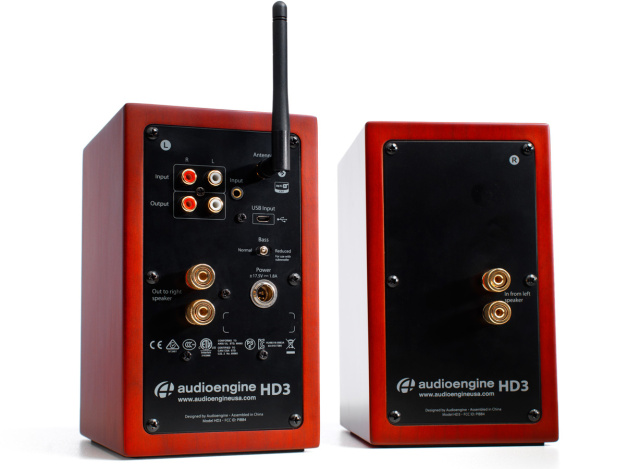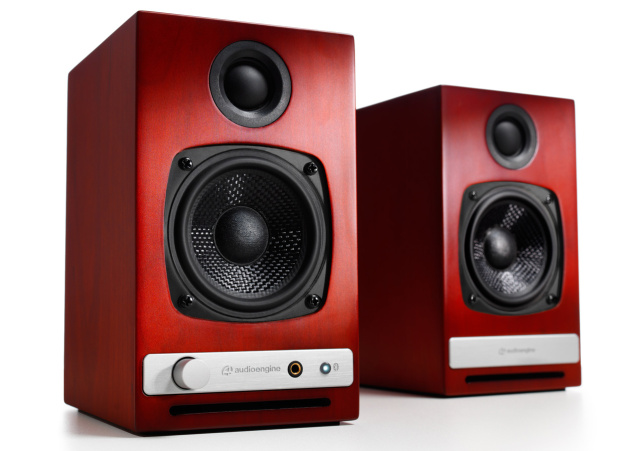In June, I reviewed the surprising Audioengine HD6 powered speakers. Playing a Bluetooth device through the HD6 speaker is the best sound I know of for the money. No, it isn’t quite truly high-end, but it sure is satisfying for a price most people can afford. I’ve personally owned a pair of Audioengine A2 powered speakers since 2008. They’ve traveled with me on vacation and played music from my iMac, and I’ve always loved them.
The guys at Audioengine told me, “Our goals for the HD3s were to use HD Series design cues, add wireless, and tune the sound to be pretty much the same as A2+ but to take it up a notch. The bass-cut switch is also a useful feature, and not only for subwoofers but people using the speakers on a more reactive (or more resonant/less dense) desktop or similar surface.” So it was with real anticipation that I unboxed the new, similar-size Audioengine HD3.
As I said, I liked the HD6s when I reviewed them, and in many ways, the HD3s are a desktop version of the HD6s. They have the same beautiful looks, the same versatile inputs and good sound for the money. They also have a very good headphone amp that can be used by just plugging your headphones into the front of the left speaker. One nice addition to the HD3s is the switch on the back to reduce the bass — a real blessing if you are positioning the speakers close to the wall. While the HD3s can be put on stands and used as speakers for a small audio system or in a video system, they really come into their own as desktop or bookshelf speakers.

Description
The HD3s are available in matte black or furniture-grade cherry or walnut wood veneer. Like the HD6 speakers, they have aluminum trim. Each HD3 speaker measures 7 by 4.3 by 5.5 inches (HWS). This size makes them small enough to be used as desktop computer speakers or to pack in a small bag and carry with you on trips. The drivers are a 0.75-inch Silk Dome tweeter and a 2.75-inch Kevlar woofer. The removable grilles snap on magnetically.
As for ease of use, the Audioengine HD3 has most connectivity option you could want. The power/volume knob is on the bottom left-hand corner of the left speaker. On the right side of this speaker are a headphone jack and a button for Bluetooth pairing. The HD3 can remember up to six devices, though it can only pair with one at a time. The amps are also in the left speaker, and all of the inputs and outputs are located on the back of this speaker. The connections include an antenna for Bluetooth reception and a binding post output for connecting the two speakers using a cable that is included. There are also RCA stereo inputs and outputs, a 3.5mm audio input for mobile devices, and a micro USB input for connecting to a computer — a way to bypass the digital-to-analog converter on your computer’s output and let the HD3 handle things. The HD3 upsamples to 24-bit PCM with its DAC.
The back panel also includes the connection for the AC adapter and the bass reduction switch that I mentioned earlier. Audioengine included the bass reduction switch for a couple of reasons. If the speakers are to be used with a subwoofer, the bass switch helps to ensure that the speakers aren’t doubling up on the same low frequencies. The second reason for the switch is to control resonance and extra bass vibrations that can occur when the speakers are placed too close to the rear wall or in a corner, a problem I had when I traveled with the A2. I have found that the bass reduction switch works great to prevent things from getting too boomy when the position of the speakers is less than optimal.
With any of these connections, the sound quality of the HD3s was very good, though the range for the Bluetooth option didn’t sound as full as the range for other options. Still, the Bluetooth option does give you the ability to quickly hook up a smartphone or tablet and stream music wirelessly if you are in a hurry. The built-in DAC sounds much better than plugging into the 3.5mm plug from laptops and desktop systems.
Click here to read the complete review on Dagogo.com or click here to read my review of the Audioengine A5+ Wireless Speakers.


